Ulysses (spacecraft)
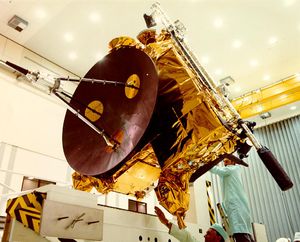 Ulysses spacecraft |
|
| Operator | NASA/ESA |
|---|---|
| Mission type | Orbiter |
| Flyby of | Jupiter |
| Satellite of | The Sun |
| Launch date | October 6, 1990 |
| Launch vehicle | Space Shuttle Discovery, STS-41 |
| Mission duration | 18 years and 9 months (6 October 1990 - 30 June 2009) |
Ulysses was a robotic space probe designed to study the Sun as a joint venture of NASA and the European Space Agency (ESA). The spacecraft was originally named Odysseus, because of its lengthy and indirect trajectory to near Solar distance. It was renamed Ulysses, the Latin translation of "Odysseus" at ESA's request in honour not only of Homer's mythological hero but also with reference to Dante's description in Dante's Inferno,[1] Originally scheduled for launch in 1986 aboard the Space Shuttle Challenger, due to the loss of Challenger, the launch of Ulysses was delayed until October 6, 1990 aboard the Space Shuttle Discovery (mission STS-41). The spacecraft's mission was to study the Sun at all latitudes. To do this required a major orbital plane shift. Due to velocity change limitations of the Shuttle and the IUS, this was accomplished by using an encounter with Jupiter to effect the plane change instead of an engine burn. The need for a Jupiter encounter meant that Ulysses could not be powered by Solar cells and was powered by a radioisotope thermoelectric generator (RTG) instead.
By February 2008, the power output from the RTG, which is generated by heat from the radioactive decay of plutonium-238, had decreased enough to leave insufficient power for internal heaters to keep the spacecraft's attitude control hydrazine fuel from freezing. The end of mission was at one point scheduled for July 1, 2008, but mission scientists came up with a method to keep the fuel liquid by conducting a short thruster burn every two hours, allowing the mission to continue.[2][3][4] The cessation of mission operations and deactivation or hibernation of the spacecraft was determined by the inability to prevent attitude control fuel from freezing.[2][5] The last day for mission operations on Ulysses was 30 June 2009.[6][7] This was a full year after the most recent previously announced mission end date. The scheduled end of mission in 2009 was the fourth time that the end of the spacecraft's mission had been scheduled.[2] The last scheduled ground station pass of the mission was over the Madrid Deep Space Network 70m ground station (DSS-63) from around 15:35 to 20:20 UTC. There were no decommissioning engineering tests on the spacecraft.
Contents |
Mission
Planning
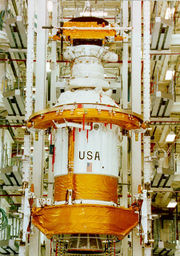
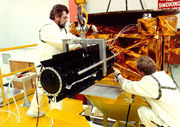
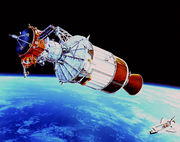
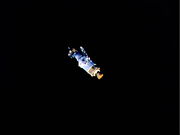
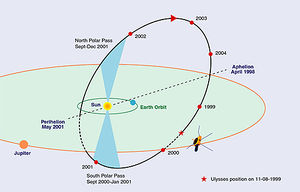
Until Ulysses, the Sun was only observed from low solar latitudes. The Earth's orbit defines the ecliptic plane, which differs from the Sun's equatorial plane by only 7.25 degrees. Even spacecraft directly orbiting the Sun do so in planes close to the ecliptic because a direct launch into a high inclination solar orbit would require a prohibitively large launch vehicle.
Several spacecraft (Mariner 10, Pioneer 11, and Voyagers 1 and 2) had performed gravity assist manoeuvres in the 1970s. Those manoeuvres were to reach other planets also orbiting close to the ecliptic, so they were mostly in-plane changes. However, gravity assists are not limited to in-plane maneuvers; a suitable flyby of Jupiter could produce a significant plane change. An Out-Of-The-Ecliptic mission (OOE) was thereby proposed. See article Pioneer H.
Originally, two spacecraft were to be built by NASA and ESA, as the International Solar Polar Mission. One would be sent over Jupiter, then under the Sun. The other would fly under Jupiter, then over the Sun. This would provide simultaneous coverage. Due to cutbacks, the US spacecraft was canceled in 1981. One spacecraft was designed, and the project recast as Ulysses, due to the indirect and untried flight path. NASA would provide the Radioisotope Thermoelectric Generator (RTG) and launch services, ESA would build the spacecraft assigned to Astrium GmbH, Friedrichshafen, Germany (formerly Dornier Systems). The instruments would be split into teams from universities and research institutes in Europe and the United States. This process provided the 10 instruments on board.
The changes delayed launch from February 1983 to May 1986 where it was to be deployed by the Space Shuttle Challenger, however, the Challenger disaster pushed the date to October 1990.
Launch
Ulysses was deployed into low-Earth orbit from the Space Shuttle Discovery. From there, it was propelled on a trajectory to Jupiter by a combination of solid rocket motors.[8] This upper stage consisted of a two-stage Boeing IUS (Inertial Upper Stage), plus a McDonnell Douglas PAM-S (Payload Assist Module-Special). The IUS was inertially stabilised and actively guided during its burn. The PAM-S was unguided and it and the Ulysses spacecraft was spun up to 80 rpm for stability at the start of its burn. On burnout of the PAM-S, the motor and spacecraft stack was yo-yo de-spun (weights deployed at the end of cables) to below 8 rpm prior to separation of the spacecraft. On leaving Earth, the spacecraft became the fastest ever artificially-accelerated object, and held that title until the New Horizons probe was launched.
On its way to Jupiter the spacecraft was in an elliptical Hohmann transfer orbit with perihelion near 1 AU and aphelion near 5 AU, Jupiter's distance from the Sun. At this time Ulysses had a low orbital inclination to the ecliptic.
Jupiter swing-by
It arrived at Jupiter February 8, 1992 for a swing-by maneuver that increased its inclination to the ecliptic by 80.2 degrees. The giant planet's gravity bent the spacecraft's flight path downward and away from the ecliptic plane. This put it into a final orbit around the Sun that would take it past the Sun's north and south poles. The size and shape of the orbit were adjusted to a much smaller degree so that aphelion remained at approximately 5 AU, Jupiter's distance from the Sun, and perihelion was somewhat greater than 1 AU, the Earth's distance from the Sun.
Solar northern polar regions
Between 1994 and 1995 it explored both the southern and northern solar polar regions, respectively.
Comet C/1996 B2 (Hyakutake)
On May 1, 1996, the spacecraft unexpectedly crossed the ion tail of Comet Hyakutake (C/1996 B2), revealing the tail to be at least 3.8 AU in length.[9][10]
Comet C/1999 T1 (McNaught-Hartley)
Encounter with a comet tail happened again in 1999 when Ulysses flew through the ion tailings of C/1999 T1 (McNaught-Hartley). A coronal mass ejection carried the cometary material to Ulysses.[10][11]
Comet C/2000 S5
Solar southern polar regions
Between 2000 and 2001 it explored the southern solar polar regions, which gave many unexpected results. In particular the southern magnetic pole was found to be much more dynamic and without any fixed clear location. It is, of course, wrong to say that the Sun has no magnetic south pole. The Sun is not a magnetic monopole; the pole is merely more diffusely located than the north pole.
Jupiter
Ulysses approached aphelion in 2003/2004 and made further distant observations of Jupiter.[12]
Comet C/2006 P1 (McNaught)
In 2007 Ulysses passed through the tail of comet C/2006 P1 (McNaught). The results were surprisingly different from its pass through Hyakutake's tail, with the measured solar wind velocity dropping from approximately 700 kilometers per second to less than 400 kilometers per second.[13]
Extended mission
ESA's Science Programme Committee approved the fourth extension of the Ulysses mission to March 2009[14] thereby allowing it to operate over the Sun's poles for the third time in 2007 and 2008. After it became clear that the power output from the spacecraft's RTG would be insufficient to operate science instruments and keep the attitude control fuel, hydrazine, from freezing, instrument power sharing was initiated. Up until then, the most important instruments had been kept online constantly, whilst others were deactivated. When the probe neared the Sun, its power-hungry heaters were turned off and all instruments were turned on.[15]
On February 22, 2008, 17 years 4 months after the launch of the spacecraft, ESA and NASA announced that mission operations for Ulysses would be likely to cease within a few months.[16][17] On April 12, 2008 NASA announced that the end date will be July 1, 2008.[18] The spacecraft operated successfully for over four times its design life. A component within the last remaining working chain of X-band downlink sub-system failed on January 15, 2008. The other chain in the X-band sub-system had previously failed in 2003.[19]
Downlink to Earth resumed on S-band, but the beamwidth of the high gain antenna on S-band is not as narrow as on X – so the downlink signal was much weaker, thereby reducing the achievable data rate. As the spacecraft traveled on its outbound trajectory to the orbit of Jupiter, the downlink signal would have eventually fallen below the receiving capability of even the largest antennas (70m in diameter) of the Deep Space Network. Even before the downlink signal was lost due to distance, the hydrazine attitude control fuel on-board the spacecraft was considered likely to freeze, as the radioisotope thermal generators failed to generate enough power for the heaters to combat the cold of space. Once the hydrazine froze, the spacecraft would no longer be able to maneuver to keep its high gain antenna pointing towards Earth, and the downlink signal would then be lost in a matter of days. The failure of the X-band communications sub-system hastened this, because the coldest part of the fuel pipework was routed over the X-band TWTAs which, when one of them was operating, kept this part of the pipework sufficiently warm.
The previously announced mission end date of July 1, 2008 came and went but mission operations continued albeit in a reduced capacity. The availability of science data gathering was limited to only when Ulysses is in contact with a ground station due to the deteriorating S-band downlink margin no longer being able to support simultaneous real-time data and tape recorder playback.[20] When the spacecraft was out of contact with a ground station, the S-band transmitter was switched off and the power was diverted to keep the internal heaters to add to the warming of the hydrazine. On June 30, 2009 ground controllers sent commands to switch to its low gain antennae which ceased communications with the spacecraft along with previous commands to schedule the shut down of its transmitter entirely.[6][21]
Results
During cruise phases, Ulysses provided unique data. As the only spacecraft out of the ecliptic with a gamma-ray instrument, Ulysses was an important part of the InterPlanetary Network (IPN). The IPN detects gamma ray bursts (GRBs); since gamma rays cannot be focused with mirrors, it was very difficult to locate GRBs with enough accuracy to study them further. Instead, several spacecraft can locate the burst through triangulation (or, more specifically, multilateration). Each spacecraft has a gamma-ray detector, with readouts noted in tiny fractions of a second. By comparing the arrival times of gamma showers with the separations of the spacecraft, a location can be determined, for follow-up with other telescopes. Because gamma rays travel at the speed of light, wide separations are needed. Typically, a determination came from comparing: one of several spacecraft orbiting the Earth, an inner-Solar-system probe (to Mars, Venus, or an asteroid), and Ulysses. When Ulysses crossed the ecliptic twice per orbit, many GRB determinations lost accuracy.
Additional discoveries:[22]
- Ulysses discovered that the Sun's magnetic field interacts with the Solar System in a more complex fashion than previously assumed.
- Ulysses discovered that dust coming into the Solar System from deep space was 30 times more abundant than previously expected.
- In 2007-2008 Ulysses determined that the magnetic field emanating from the Sun's poles is much weaker than previously observed.
- That the solar wind has "grown progressively weaker during the mission and is currently at its weakest since the start of the Space Age."[21]
Spacecraft
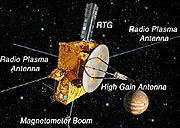
The spacecraft body is roughly a box, approximately 3.2 × 3.3 × 2.1 m in size. The box mounted the 1.65 m dish antenna and the RTG power source. The box was divided into noisy and quiet sections. The noisy section abutted the RTG; the quiet section housed the instrument electronics. Particularly "loud" components, such as the preamps for the radio dipole, were mounted outside the structure entirely, and the box acted as a Faraday cage.
Ulysses is spin-stabilised about its z-axis which roughly coincides with the axis of the dish antenna. The RTG, whip antennas, and instrument boom are placed to stabilize this axis. Spin is nominally 5 rpm. Inside the body is a hydrazine fuel tank. Hydrazine monopropellant was used for course corrections inbound to Jupiter, and is now used exclusively to repoint the spin axis (and thus, the antenna) at Earth. The spacecraft is controlled by eight thrusters, in two blocks. Thrusters are pulsed in the time domain to perform rotation or translation. Four Sun sensors detected orientation. For fine attitude control, the S-band antenna feed is mounted slightly off-axis. This offset feed combined with the spacecraft spin introduces an oscillation to an S-band radio signal transmitted from Earth when received on-board the spacecraft. The amplitude and phase of this oscillation is proportional to the oriention of the spin axis relative to the Earth direction. This method of determining the relative orientation is called CONSCAN and was widely employed in early infra-red guided missiles.
The spacecraft uses S-band for uplinked commands and downlinked telemetry, through dual redundant 5-watt transceivers. The spacecraft used X-band for science return (downlink only), using dual 20W TWTAs until the failure of the last remaining TWTA in January 2008. Both bands use the dish antenna with prime-focus feeds, unlike the Cassegrain feeds of most other spacecraft dishes.
Dual tape recorders, each of approximately 45 megabit capacity, store science data between the nominal 8-hour communications sessions during the prime and extended mission phases.
The spacecraft is designed to withstand both the heat of the inner Solar System and the cold at Jupiter distance. Extensive blanketing and electric heaters protect against cold.
Total mass at launch was 366.7 kg of which 33.5 kg was hydrazine (used for attitude control and orbit correction).
Instruments
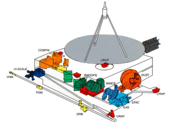

Radio/Plasma antennas. Two beryllium-copper antennas unreeled outwards from the body, perpendicular to the RTG and spin axis. Together this dipole spanned 72 meters. A third antenna, of hollow beryllium-copper, deployed from the body, along the spin axis opposite the dish. It was a monopole antenna, 7.5 meters long. These measured radio waves generated by plasma releases, or the plasma itself as it passed over the spacecraft. This receiver ensemble was sensitive from dc to 1 MHz.[23]
Experiment Boom. A third type of boom, shorter and much more rigid, extended from the last side of the spacecraft, opposite the RTG. This was a hollow carbon-fiber tube, of 50 mm diameter. It can be seen in the photo as the silver rod stowed alongside the body. It carried four types of instruments. A solid-state X-ray instrument, which was composed of two silicon detectors to study X-rays from solar flares and Jupiter's aurorae. The GRB experiment consisted of two CsI scintillator crystals with photomultipliers. Two different magnetometers were mounted: a vector helium magnetometer and a fluxgate magnetometer. A two axis magnetic search coil antenna measured AC magnetic fields.
Body-Mounted Instruments. Detectors for electrons, ions, neutral gas, dust, and cosmic rays were mounted on the spacecraft body around the quiet section.
- SWOOPS (Solar Wind Observations Over the Poles of the Sun) measures positive ions and electrons.[24]
Lastly, the radio communications link could be used to search for gravitational waves[25] (through Doppler shifts) and to probe the Sun's atmosphere through occultation. No gravitational waves were detected.
Total instrument mass is 55 kg.
References
- ↑ "Inferno of Ulysses' urge to explore an uninhabited world behind the Sun. In Jane's Spaceflight Directory 1988, ISBN 0-710-60860-8
- ↑ 2.0 2.1 2.2 "Light goes out on solar mission". BBC News (British Broadcasting Company). June 26, 2009. http://news.bbc.co.uk/2/hi/science/nature/8121625.stm. Retrieved June 26, 2009.
- ↑ ESA Portal – Sun to set on Ulysses solar mission on 1 July
- ↑ ESA Portal – Ulysses hanging on valiantly
- ↑ Solar wind blows at 50-year low 2008-09-24, Jonathan Amos, BBC News Online. Retrieved 2008-09-28
- ↑ 6.0 6.1 "Ulysses: 12 extra months of valuable science". European Space Agency. 30 June 2009. http://www.esa.int/esaCP/SEMWHF1P0WF_index_0.html. Retrieved 2009-07-01.
- ↑ The odyssey concludes ...
- ↑ ESA - Space Science - Sun to set on Ulysses solar mission on 1 July
- ↑ Jones GH, Balogh A, Horbury TS (2000). "Identification of comet Hyakutake's extremely long ion tail from magnetic field signatures". Nature 404 (6778): 574–6. doi:10.1038/35007011. PMID 10766233.
- ↑ 10.0 10.1 10.2 Ulysses Catches Another Comet by the Tail
- ↑ 11.0 11.1 G. Gloeckler et al. Cometary Ions Trapped in a Coronal Mass Ejection
- ↑ Ulysses - Science - Jupiter Distant Encounter Selected References
- ↑ Neugebauer, Gloeckle; et al. (October 1 2007). "Encounter of the Ulysses Spacecraft with the Ion Tail of Comet McNaught" (abstract). The Astrophysical Journal 667 (2): 1262–1266. doi:10.1086/521019. http://www.journals.uchicago.edu/doi/abs/10.1086/521019.
- ↑ ESA Science & Technology: Ulysses Mission Extended
- ↑ ESA Portal – Ulysses scores a hat-trick
- ↑ "Ulysses mission coming to a natural end". European Space Agency. 2008-02-22. http://www.esa.int/esaCP/SEM6UE3CXCF_index_0.html. Retrieved 2008-02-23.
- ↑ "International Solar Mission to End Following Stellar Performance". NASA. 2008-02-22. http://www.nasa.gov/topics/solarsystem/features/ulysses-20080222.html. Retrieved 2008-02-23.
- ↑ http://news.yahoo.com/s/ap/20080612/ap_on_sc/sci_solar_probe
- ↑ "February 2003 Operations". European Space Agency. http://ulysses-ops.jpl.esa.int/ulsfct/opsfiles/03feb_ops.html.
- ↑ Ulysses Mission Ops - No more data playback
- ↑ 21.0 21.1 "Ulysses Spacecraft Ends Historic Mission of Discovery". June 30 2009. http://www.jpl.nasa.gov/news/news.cfm?release=2009-104. Retrieved 2009-07-01.
- ↑ NASA : International Mission Studying Sun to Conclude
- ↑ Unified Radio and Plasma Wave Investigation, JPL
- ↑ Goldstein, Bruce. SWOOPS/Electron – User Notes, Jet Propulsion Laboratory
- ↑ The Gravity Wave Experiment, Astronomy and Astrophysics
External links
- ESA Ulysses website
- ESA Ulysses mission operations website
- ESA Ulysses Home page
- NASA/JPL Ulysses website
- Ulysses Measuring Mission Profile by NASA's Solar System Exploration
- ESA/NASA/JPL: Ulysses subsystems and instrumentation in high detail
- Where is Ulysses now!
- Max Planck Institute Ulysses website
- Interview with Ulysses Mission Operations Manager Nigel Angold on Planetary Radio
|
||||||||||||||||
|
|||||||||||||||||||||||
|
|||||||||||||||||||||||||||||||||||||||||||||||
